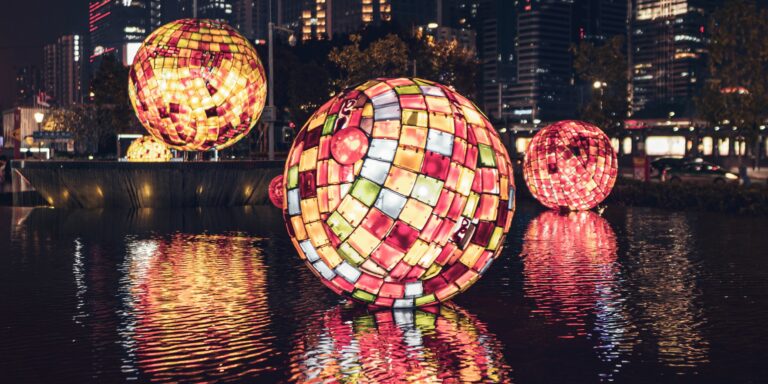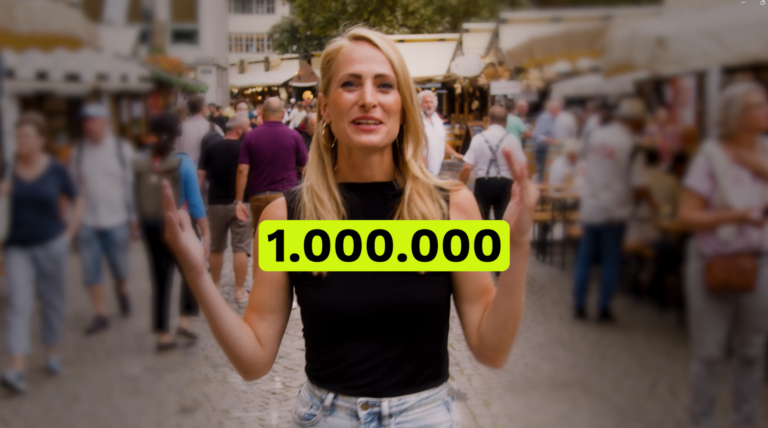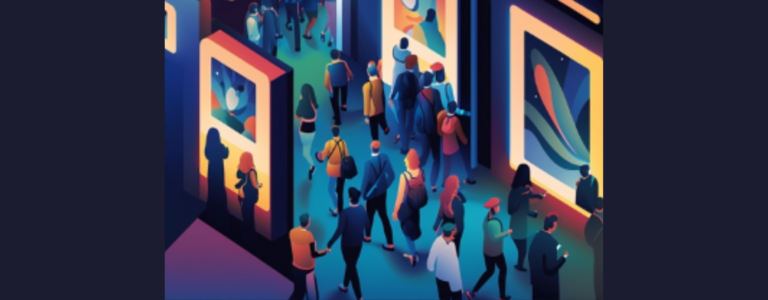Events and trade fairs are often like vibrant microcosms where a multitude of activities, stands and programme items come together. From high-calibre speeches to interactive exhibitions and networking opportunities, these events offer a wealth of opportunities and information. But amidst this rich offering lies a challenge that is often overlooked: finding your way around.
The complexity of such events can be overwhelming. Visitors navigate through countless halls, roam between different stands and juggle a busy schedule of talks and presentations. In this maze of possibilities, clear orientation is crucial – not only for the visitor experience, but also for the success of the event as a whole.
Simple and intuitive guidance is key to ensuring that visitors get the most out of their time at the event. Without a clear guideline, potential leads can be lost, important information overlooked and visitor engagement diminished. It is therefore imperative that organisers consider effective solutions to help their guests navigate the event and create a positive experience that they will remember for a long time to come.
The diversity of orientation needs at events
At events and trade fairs, wayfinding needs are diverse and extend across different areas. Here are some of the most important points:
- Indoor navigation: visitors need clear instructions to find their way around the often labyrinthine halls and rooms. Precise indoor navigation is therefore essential to ensure that they can easily reach their desired destinations.
- Programme overview: With an abundance of lectures, workshops and presentations, it is important that visitors have an overview of the entire programme. A well-structured programme overview allows them to plan their time efficiently and ensure they don’t miss any important events.
- Locations of important points: In addition to the main stages and event spaces, visitors also need to be able to find other key points, such as food areas, toilets, rest areas or information stands. Clear signage and labelling of these locations is crucial to ensure a seamless experience.
- Thematic orientation: As events often cover specific themes or industries, it is important that visitors can easily find the content that is relevant to them. Clearly structuring and labelling the different areas or themed pavilions helps to facilitate orientation and guide visitors in a targeted manner.
- Interactive elements: Some visitors may be looking for interactive experiences or special attractions on the event site. Clearly labelling such elements and integrating them into the navigation solution allows visitors to search specifically for these highlights and maximise their experience.
The diversity of these wayfinding needs highlights the need for a comprehensive and well-designed solution to optimise the visitor experience and promote the success of the event.
Challenges of traditional wayfinding methods
Traditional wayfinding methods such as printed maps, programmes and signage undoubtedly have their place in event planning, but they are not without their limitations. These methods often reach their limits when it comes to providing visitors with efficient and personalised wayfinding.
Printed maps and programme booklets, while providing a basic overview of the event site and programme, often suffer from confusion and limited updating capabilities. Visitors can feel lost in a sea of information, especially if the event is large and diverse. In addition, printed materials require regular updates to reflect changes in the programme or locations, which can lead to additional work and costs for organisers – and depending on the timing, can become downright impossible.
On-site signage can also be inadequate, especially if it is not clear enough or not placed in strategic locations. This can lead to confusion and cause additional stress for visitors as they try to find their way. In addition, the use of printed materials contributes to the environmental impact of paper, which is an increasing concern for many organisers and visitors.
Another key problem with traditional wayfinding methods is the lack of personalisation options for the visitor. Printed materials cannot cater to the individual needs and preferences of each visitor, meaning they may miss out on relevant information or activities tailored to their specific interests.
With these challenges in mind, it’s clear that traditional wayfinding methods alone may no longer be enough to fulfil the complex needs of modern events. A digital solution such as an event app offers an attractive alternative that can overcome these issues and provide visitors with a seamless and personalised orientation experience.
Publish your place for free
Get unlimited access to all features for 14 days. Upload your content in minutes, publish your interactive place and see for yourself how your visitors interact with UpVisit in your space.
No payment information required
No need to cancel, trial ends automatically
All features included
The advantages of a digital solution: the event app
Digital solutions such as event apps are a promising alternative to traditional orientation methods as they offer a variety of benefits to improve the visitor experience:
- Indoor navigation: Clear instructions and interactive maps allow visitors to navigate effortlessly through complex venues.
- Personalised schedules: Visitors can create their own programme, mark important events and set reminders to ensure they don’t miss anything.
- Flexibility and updatability: Information can be updated in real time to reflect changes in the programme or locations, and visitors have access to the latest information at all times.
- Personalisation options: An app can provide customised recommendations and notifications based on visitors’ interests and activities to increase their engagement with the event.
- Ease of use: A user-friendly interface makes it easy to access all the information they need, improving the overall visitor experience.
- Efficient communication: The app facilitates communication between organisers and visitors, resulting in smooth organisation and improved information sharing. Push notifications can be used to inform visitors about special offers, but also in the event of an emergency.
- Sustainability: Compared to printed materials, the use of a digital solution such as an event app reduces paper consumption and thus contributes to the environmental friendliness of the event.
Thanks to these diverse functions, event apps make a significant contribution to overcoming the challenges of orientation at events and creating an optimal visitor experience.
Practical advice and recommendations:
For organisers considering an event app to improve visitor orientation, here are some practical tips and recommendations:
- Choose a platform solution: Opt for an event app that is offered as a platform solution. These solutions are often quick and inexpensive to implement and offer the advantage that they are always kept technologically up to date.
- Consider the needs of your visitors: Make sure that the selected event app offers functions that improve visitor orientation. This includes user-friendly indoor navigation, personalised schedules, location markers and interactive maps.
- Integration of relevant functions: Integrate features that further enhance the visitor experience, such as the ability to mark favourites, provide feedback, social media integration for experience sharing or live stream integration for visitors who cannot be onsite.
- Visibility of the app before the event and on site: Make the event app clearly visible, both before the event through marketing measures and on your website, as well as on site through signage and notices.
- Provide training and support: Ensure that your team and visitors are informed about how to use the event app. Provide on-site training and support to ensure that visitors can make the most of the app and benefit from its advantages.
To summarise, it can be said that good orientation, both physically and in terms of content, is crucial for the success of events. The challenges associated with navigating complex venues and an extensive programme can be effectively overcome by digital solutions such as event apps. These not only offer user-friendly indoor navigation and personalised schedules, but also enable relevant content to be found in a targeted manner and the visitor experience to be optimised.
Continuous development and innovation in the field of event technologies promises even more opportunities to improve visitor orientation in the future. From augmented reality applications and intelligent chatbots to even more intuitive navigation solutions, there are numerous exciting developments that can help to make events even more attractive and successful.
It is to be hoped that organisers will increasingly use these technologies to offer their visitors an unforgettable experience and further increase the chances of success of their events. After all, effective orientation is the key to a successful event that inspires and retains visitors in the long term.



